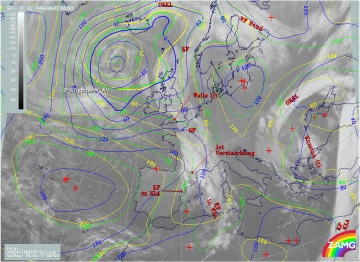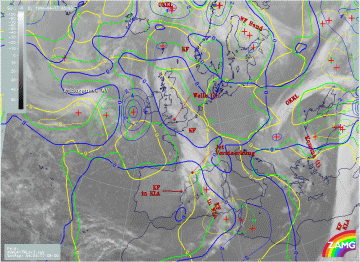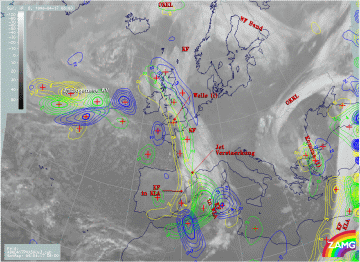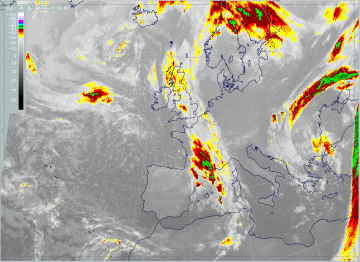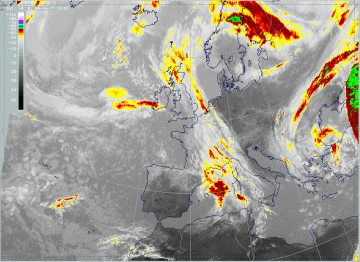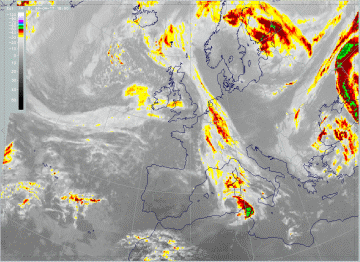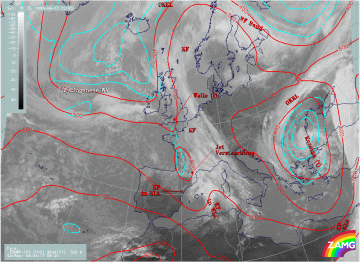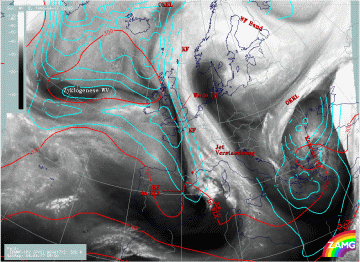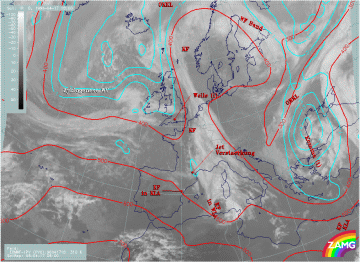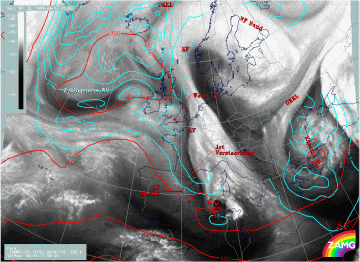17 April 1996 - Rapid Cyclogenesis: Forecast For "Special Investigation" 17 April 12.00 Utc To 18.00 UTC
|
17 April 1996/06.00 UTC - Meteosat IR image; SatRep overlay: names of conceptual models, SatRep menu: key parameters for Rapid
Cyclogenesis forecast
|
|
Concerning the forecast of the conceptual model "Rapid Cyclogenesis" in the SatRep Menu, a button "Vorhersage" = forecast has to be clicked and then the relevant menu appears. As can be seen, two kinds of forecasts and forecast times are presented:
The very short range forecast VSRF (06.00 - 18.00 UTC, 12 hours)
For the very short range forecast, six-hourly forecasts from ECMWF are used and those parameters which are key parameters of a conceptual model are prepared as overlays on the satellite image in three different colours representing the three points of time 06.00, 12.00 and 18.00 UTC:
- yellow: 06.00 UTC
- green: 12.00 UTC
- blue: 18.00 UTC
In the case of the conceptual model "Wave", the thermal front parameter (TFP), the height contours of 1000 hPa, warm advection (TA>=0) and the maxima of positive vorticity advection (PVA500>=2) are taken into account.
Nowcasting (0-2 hours)
For this forecast time atmospheric motion vectors (AMVs) are used which extrapolate the cloud systems for the next two hours. These nowcasts are renewed half-hourly or hourly and are not discussed here.
|
17 April 1996/06.00 UTC - Meteosat IR image; yellow: height contours 1000 hPa 06.00 UTC, green: height contours 1000 hPa 12.00 UTC,
blue: height contours 1000 hPa 18.00 UTC; SatRep overlay: names of conceptual models
|
17 April 1996/06.00 UTC - Meteosat IR image; yellow: temperature advection - WA 1000 hPa 06.00 UTC, green: temperature advection - WA
1000 hPa 12.00 UTC, blue: temperature advection - WA 1000 hPa 18.00 UTC; SatRep overlay: names of conceptual models
|
|
17 April 1996/06.00 UTC - Meteosat IR image; yellow: positive vorticity advection (PVA) 500 hPa 06.00 UTC, green: positive vorticity
advection (PVA) 500 hPa 12.00 UTC, blue: positive vorticity advection (PVA) 500 hPa 18.00 UTC; SatRep overlay: names of conceptual
models
|
|
All three key parameters show an eastward propagation towards Ireland with good agreement for the next two points of time; there are minor deviations between the WA maximum which is fastest and the surface low centre which is slowest.
|
17 April 1996/06.00 UTC - Meteosat IR enhanced image
|
17 April 1996/06.00 UTC - Meteosat IR enhanced image
|
|
17 April 1996/06.00 UTC - Meteosat IR enhanced image
|
|
The images for the 12 hours period show very clearly the typical stages of cloud development in the case of a Rapid Cyclogenesis (compare Conceptual Models: Rapid Cyclogenesis - Cloud structure in satellite images ).
For the diagnosis stage additional parameters like PV have been discussed and it was concluded that a low isentropic level does not contain any stratospheric air in the area under consideration and that a higher isentropic level shows some typical features in this key parameter but somewhat displaced to the south (compare Rapid Cyclogenesis: Diagnosis for 17 April 06.00 UTC ). Bearing this result in mind, the forecast fields of PV can be understood in the same manner.
|
17 April 1996/12.00 UTC - Meteosat IR image; cyan: potential vorticity (PV) 305K, red: isobars; SatRep overlay: names of conceptual
models
|
17 April 1996/12.00 UTC - Meteosat IR image; cyan: potential vorticity (PV) 320K, red: isobars; SatRep overlay: names of conceptual
models
|
|
17 April 1996/18.00 UTC - Meteosat IR image; cyan: potential vorticity (PV) 310K, red: isobars; SatRep overlay: names of conceptual
models
|
17 April 1996/18.00 UTC - Meteosat IR image; cyan: potential vorticity (PV) 320K, red: isobars; SatRep overlay: names of conceptual
models
|
For the lower 305K and 310K levels, the very small isolines representing PV unit 1 close to the cloud spiral may be interpreted as indicating that a Rapid Cyclogensis process is taking place in higher layers. These higher layers represented by the 320K level show indeed PV values of 2 units but compared with the images, especially with the dark stripes in the WV imagery, a southward shift can also be observed in the forecasts.
This is a case of Rapid Cyclogensis, where the numerical model of ECMWF is not completely ignoring this process but should be corrected at least in respect to the position.

